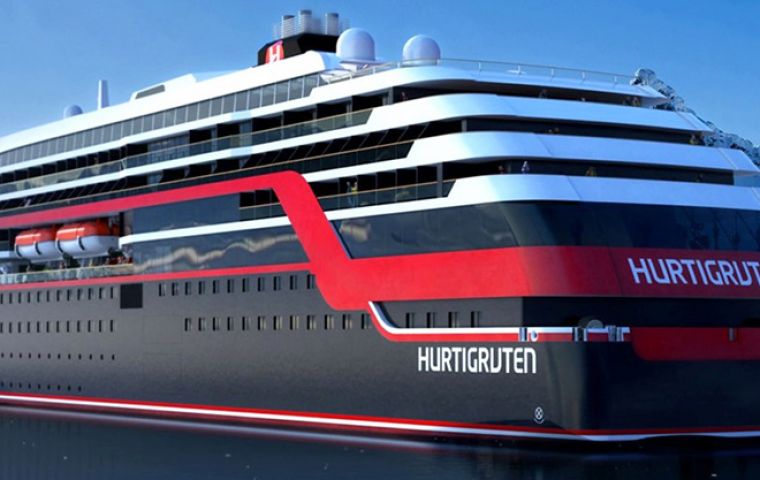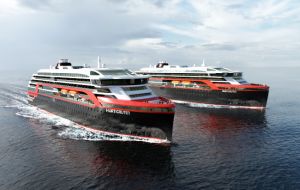MercoPress. South Atlantic News Agency
Falklands' call for “the world's greenest cruise ship”, MS Roald Amundsen
 The MS Roald Amundsen is part of an initiative to prove to the world that hybrid propulsion is not only possible, but it is the future of sustainable cruise travel.
The MS Roald Amundsen is part of an initiative to prove to the world that hybrid propulsion is not only possible, but it is the future of sustainable cruise travel. From an environmental perspective, it’s easy to see how cruise ships have long been one of the harshest modes of travel. They’re big, slow, fuel-hungry, and rife with excess. However, forward-thinking cruise line Hurtigruten is looking to change the game with the launch of what they’re calling “the world’s greenest cruise ship.”
In 2018, the MS Roald Amundsen — named for legendary Norwegian explorer Roald Amundsen — will set sail for the world’s southernmost reaches. The ship’s first itinerary will head to Patagonia, the fjords of Chile, and the Falkland Islands before pushing onward to the Polar Circle and, finally, Antarctica. While the itinerary alone is worthy of the company’s hardcore nature exploration ethos, it’s what’s under the eco-friendly cruise ship’s hull that’s truly noteworthy. The long list of state-of-the-art marine technology will include a best-in-class hybrid engine that is powered by electricity and designed to be the world’s most environmentally conscious by substantially reducing fossil fuel consumption.
The MS Roald Amundsen is part of an initiative to prove to the world that hybrid propulsion is not only possible, but it is the future of sustainable cruise travel. The vessel will be the first of two hybrid ships added to Hurtigruten’s fleet in the coming years. The technology on both ships will also feature a cutting-edge hull construction and better use of onboard electrical systems to cut CO2 emissions by as much as 20%.
Beyond the high-tech engineering, the ship is sleek, comfortable, and thoroughly modern on the inside. A two-story indoor/outdoor observation deck wraps around the bow of the ship to offer panoramic views. As the ship will be part luxury cruise liner and part research station, it will also include installations designed to educate passengers about their destinations. A science center behind the observation deck will be outfitted with touch screens and other interactive tech with access to a wealth of information about the wildlife and terrain outside. Every cabin offers a window, while half boast private balconies. Suites even upgrade to private Jacuzzis. The ship also features plenty of creature comforts including a pool deck, a sauna, a gym, three restaurants, and a bar.
The technology promises a better all-around experience onboard as it allows the ships to sail silently. This is a substantial breakthrough for polar exploration vessels as it provides for unprecedented, up-close access to marine wildlife.





Top Comments
Disclaimer & comment rules-

-

-

Read all commentsIts actually powered by RR Diesels. So ultimately powered by fuel oil. Electricity might turn the screws and the propulsion may be efficient but the description is a tad misleading. Hope its ice strengthened...
Dec 15th, 2017 - 01:49 pm 0As I understand it, this is the propulsion system that was on the ARA San Juan.
Dec 17th, 2017 - 12:54 pm 0England will return the Malvinas within 25 years.
Dec 21st, 2017 - 03:28 am 0Commenting for this story is now closed.
If you have a Facebook account, become a fan and comment on our Facebook Page!